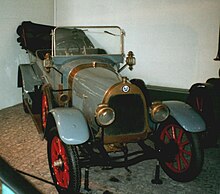Fisherman cart
Fischer was a Swiss manufacturer of automobiles .
Company history
The company Fischer-Wagen AG was founded in 1908 by Martin Fischer with the help of a silk manufacturer in Zurich after he had left Turicum AG .
Fischer developed a side-operated slide motor , the single slide of which was designed to perform a double movement; it oscillated and continuously changed its direction of rotation. This was also a very early engine in monobloc design; d. H. no longer with cylinder blocks cast in pairs.
In 1911 the engine was shown at the Berlin Motor Show. As a result, several automobile manufacturers acquired licenses for replicas: In Orléans , the automobile and commercial vehicle manufacturer Delaugère & Clayette became aware of the Fischer system and was licensed to manufacture engines for the 2.7 liter Type SS ("SS": Sans Soupapes ; valveless). This business relationship ended with the outbreak of the First World War .
The collaboration with another small manufacturer, De Bazelaire in Paris , who experimented with a six-cylinder engine in 1913, but ultimately with bought-in engines from Ballot resp. rapidly obsolescent T-head engines from Janvier remained.
Representatives of the Aristos Company in New York City had also seen the engine in Berlin. They acquired a license to manufacture their planned luxury car, Mondex-Magic , and in 1914 and 1915 produced two models in the top price range. Both had six-cylinder engines according to the Fischer patent; the smaller one had a displacement of 4.2 liters and 40 hp according to the calculation formula at the time, the larger one 7 liters and 60 hp; the latter was also used in the Palmer-Singer Magic Six , which appeared in January 1914. In 1919 there was a collaboration with the Swiss Industrial Society , or SIG for short . Production was stopped in 1922.
In the end, Fischer had far less success with his engine than Charles Yale Knight , whose principle prevailed for a while and was used by leading brands such as Mercedes , Daimler , Minerva , Panhard & Levassor or Voisin in some cases until the 1930s. There is evidence that the engine was not performing well. When Palmer-Singer went bankrupt in March 1914, "expensive experiments" were cited as one of the reasons.
vehicles
The first 16/22 hp model had a four-cylinder engine with 2011 cc displacement and 70 copies were produced from 1908 to 1911. Between 1911 and 1914, 200 units of the successor model with a four-cylinder slide engine, which developed between 33 and 35 hp , were produced. In 1914 two copies of the 40 HP SS model with a six-cylinder slide engine, 4100 cc displacement and 40 HP output were also produced. From 1919 the last model was a small car with two seats in tandem, powered by a V2 engine from MAG .
Two vehicles of this brand can be viewed in the Swiss Museum of Transport in Lucerne .
Licensee
- Aristos Company (New York City, New York , USA )
- De Bazelaire ( Paris , France)
- Delaugère & Clayette ( Orléans , Loiret , France )
- Palmer & Singer Manufacturing Company ( Long Island City , New York, USA)
literature
- Harald H. Linz, Halwart Schrader : The great automobile encyclopedia. BLV, Munich 1986, ISBN 3-405-12974-5
- George Nick Georgano : Cars. Encyclopédie complète. 1885 à nos jours. Courtille, 1975 (French)
- GN Georgano (Ed.): Complete Encyclopedia of Motorcars, 1885 to the Present ; Dutton Press, New York, 2nd edition (hardcover) 1973, ISBN 0-525-08351-0 (English)
- Ernest Schmid: Swiss cars. Swiss automobile designs from 1868 to the present day. Auto-Jahr, Lausanne 1978, ISBN 2-88001-058-6
Web links
- GTÜ Society for Technical Monitoring mbH (accessed on December 22, 2013)
- “An automobile called Zurich - the turicum of the watchmaker and designer Fischer” , Neue Zürcher Zeitung , February 7, 2001
- motorsnaps.com: Story of Delaugère & Clayette (accessed August 22, 2012)
Individual evidence
- ^ Georgano: Complete Encyclopedia of Motorcars ; 2nd ed. (1973), p. 533
- ↑ a b Georgano: Complete Encyclopedia of Motorcars ; 2nd ed. (1973), pp. 234-235
- ^ Georgano: Complete Encyclopedia of Motorcars ; 2nd ed. (1973), p. 493
- ↑ a b Kimes (1985), p. 949
- ↑ a b Kimes (1996), pp. 1147-1148
- ^ Georgano: Complete Encyclopedia of Motorcars ; 2nd ed. (1973), p. 241
- ↑ Kimes (1985), pp. 1106-1107
